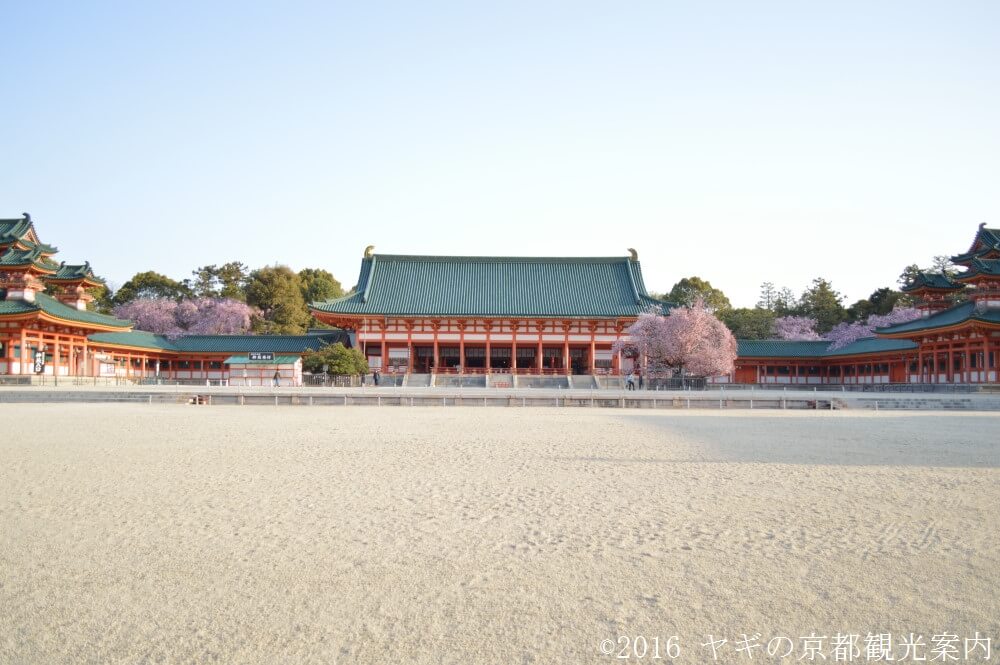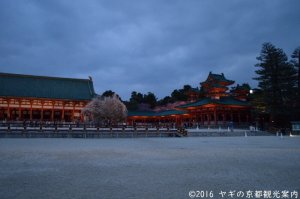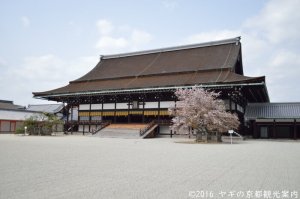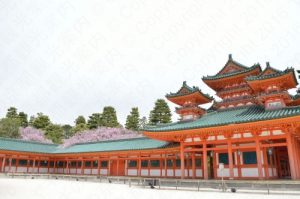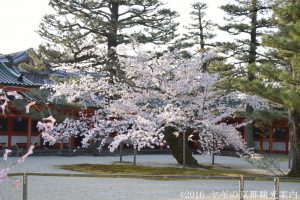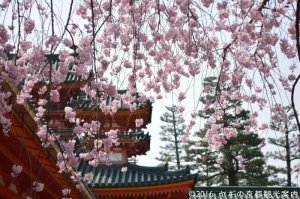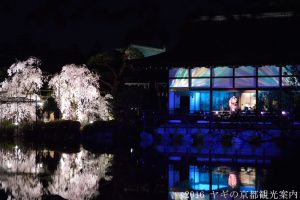Cherry blossoms 桜
Sakon no Sakura (左近の桜)
In front of Gaihaiden, or Daigokuden in the old days, there is a cherry blossom tree named Sakon no Sakura (左近の桜). Sakon (左近) is abbreviated “Hidari Konoe (左近衛),” a rank of officer. When important ceremony like enthronement was held, Hidari Konoe seated himself on the left side of Daigoku-den. Sakon no Sakura was named after the custom.
Today Shisin-den (紫宸殿) in Kyoto Imperial Palace also has Sakon no Sakura. Shisin-den is a building in Dairi, or the emperor’s residence. As time went by, Daigokuden lost its importance and significant ceremonies were held in Shisin-den. So, it has Sakono Sakura. The Sakon no Sakura is a mother tree of that of Heian Jingu shrine. So, they are in bloom at the same time.
Up on the roof (屋根の上)
On the roof of the corridor connected to Gaihai-den, cherry blossoms in Shin-en weep. It is very hard to foresee when we adore them because they go into full bloom all of a sudden and gone away.
Somei Yoshino (染井吉野)
Somei Yoshino is the most popular cherry blossom in Japan. It is equivalent to the word “Sakura.” The most amazing one is located near Kagura-den.
Weeping cherry blossom in Shin-en (神苑の枝垂桜)
As we discussed, Shin-en has many stunning cherry blossoms.
In every April, Beni Shidare concert is held there at night. Famous artist plays compositions related to Spring. Spring so much mean to Japanese people because it gives them conviction that life starts again.

Jidai Matsuri fesitval 時代祭
On December 22th in 794, emperor Kannmu shifted Japanese capital to Kyoto. Today, Kyotoites adore Jidai Matsuri festival.
Jidai matsuri festival (時代祭) is one of “Three great festival” in Kyoto. In this festival, over 2,000 people parade from Heian Jingu shrine to Kyoto Imperial palace. The parade tells us what Japanese history is. The participants dress themselves in clothes of ancient times. All of them are made in authentic ways.

Daina no gi 大難の儀
In every February, Setsubun rituals are carried on through the archipelago. Daina no gi was the annual event in the Imperial court and is the origin of them.

About Heian Jingu shrine 基本情報
The following information might be changed. Check them at the official website of Heian Jingu shrine.
Official name
Heian Jingu shrine 平安神宮
Address
Okazaki Nishitennocho, Sakyo Ward, Kyoto, Kyoto Prefecture 606-8341
Phone no.
075-761-0221
Website
Heian Jingu shrine official HP(with English translation)
Opening hours
Heian Jingu shrine
From Feb. 15 to Feb. 28
Heian Jingu shrine 6:00-17:30
Shinen garden 8:30-16:30
From Mar. 1 to Mar. 14
Heian Jingu shrine 6:00-17:30
Shinen garden 8:30-17:00
From Mar. 15 to Sep. 30
Heian Jingu shrine 6:00-18:00
Shinen garden 8:30-17:30
From Oct. 1 to Oct. 31
Heian Jingu shrine 6:00-17:30
Shinen garden 8:30-17:30
From Nov. 1 to Feb. 14
Heian Jingu shrine 6:00-17:00
Shinen garden 8:30-16:30
Shin-en garden
Around 8:30~17:00 (It depends on seasons. See the official website.)
Entrance fee
Heian Jingu shrine
Free
Shin-en garden
Adult: 600 yen.
Time required
Heian Jingu shrine
20 minutes~
Shin-en garden
1 hour~
How to get to Heian Jingu shrine? アクセス
Kyoto city bus No. 5, 46,100 and 110
Get off at “Okazeki-koen, Bijutsukan, Heian Jingu mae” bus stop.
Kyoto city bus No. 32, 93, 203 and 204
Get off at “Okazaki michi” bus stop.
Kyoto city bus No. 201, 202 and 206
Get off at “Higashiyama Nijo, Okazaki Koen guchi” bus stop.
ヤギの京都観光案内/KYOTO GOAT BLOGをもっと見る
購読すると最新の投稿がメールで送信されます。

